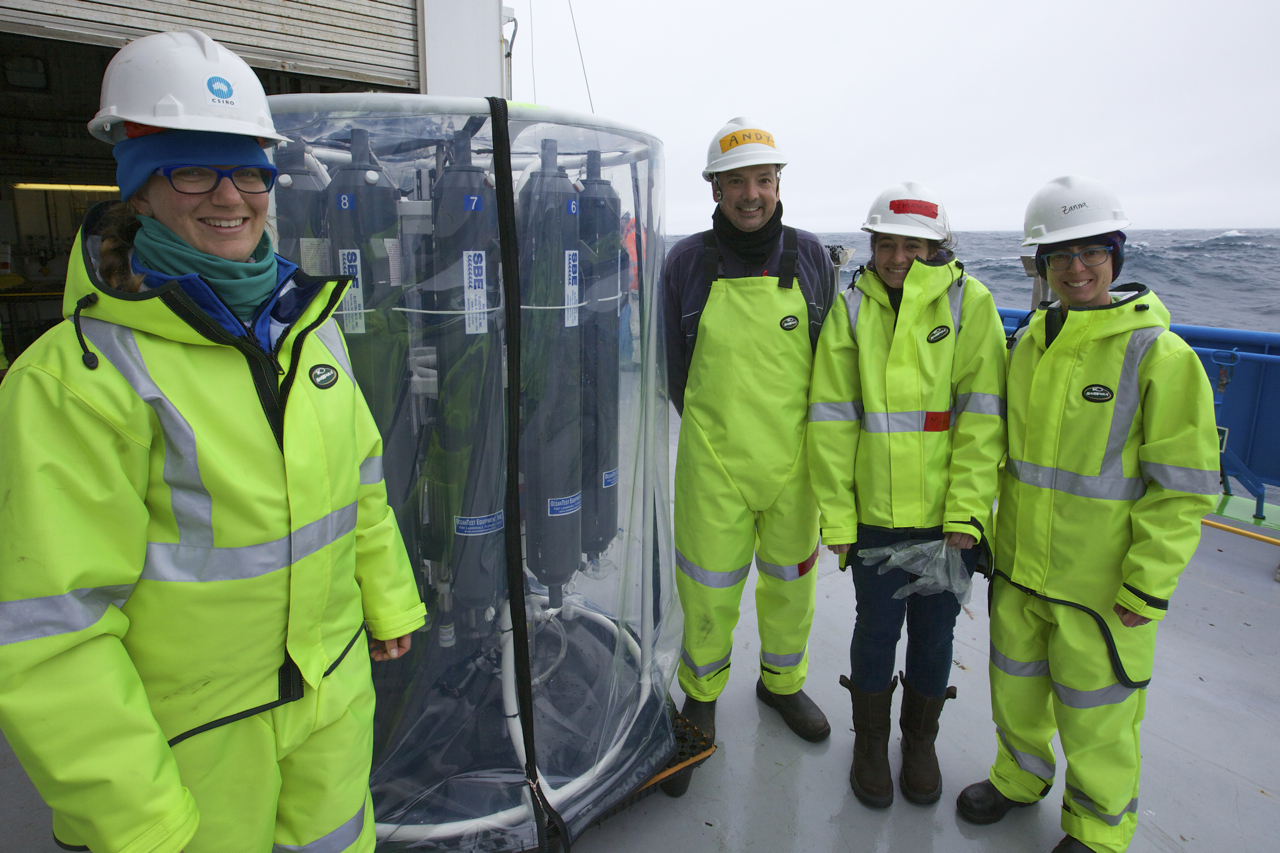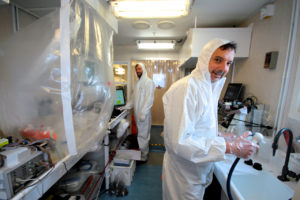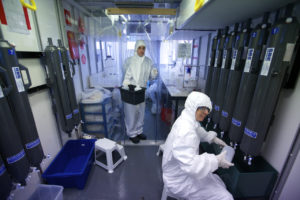In this blog Andrew Bowie shares his latest research and what it’s like working in the windiest and wildest ocean in the world.

Four people wearing yellow high vis suits and hard hats standing on the deck of a ship with piece of marine sampling equipment
From L-R: Dr Kathrin Wuttig, A/Prof Andrew Bowie, Manon Tonnard and A/Prof Zanna Chase on deck with the TMR safely protected under its cover.
In this blog Andrew Bowie shares his latest research and what it’s like working in the windiest and wildest ocean in the world.
By A/Prof Andrew Bowie, Co-Chief Scientist aboard RV Investigator voyage IN2016_V01
Trace elements like iron are the building blocks of life for biological organisms in oceans, but with the Southern Ocean being one of the most iron-deficient oceans in the world, it makes it an extremely difficult place to sustain a healthy marine ecosystem.
The region north of Heard and McDonald islands on the Kerguelen plateau, however, differs from most of the Southern Ocean in that it’s able to sustain large blooms of phytoplankton. So we’re measuring the iron levels in the waters here to try to find out where the extra iron is coming from that makes this ecosystem healthier than others in the region.
Our hypothesis is that the elevated levels of iron, particularly near the volcanic McDonald Islands, is partly being delivered by submarine volcanoes (hydrothermal vents) in the waters around the islands, and partly by volcanic ash from the erupting volcano mixing with active glaciers on Heard Island, and dispersing in the surrounding ocean.
If we can confirm this hypothesis (our results are looking pretty good so far) then it will have broader implications for the health and ecosystem vitality of the Southern Ocean.
See their research in action
What we’re testing
We’re taking samples of the ocean’s water and measuring the trace metals such as iron, copper, zinc, cadmium, and their more exotic ‘isotopes’, but it’s not exactly a simple process.
They’re found in such a low concentration (pico grams – that’s 1 x 10-12g per gram of seawater) that we need to be extremely precise in our measurements. To put this in perspective, it’s like trying to find a pinhead in 1000 Olympic swimming pools!
Because we’re on a ship and surrounded by metal we need to take extra precautions, and use specialised equipment to prevent contamination of the seawater samples.
Our specialised equipment
The primary piece of equipment we use to take samples is a Trace metal rosette (TMR), which is a specialised piece of equipment similar to a CTD (Conductivity, Temperature and Depth) rosette, except it’s designed to be as metal free as possible to avoid interfering with our samples, and where metal has to be used, it’s of the highest quality, such as titanium bolts and pins and a powder coated aluminium frame.
The design revolves around a dozen 12-litre Niskin bottles manufactured with an internal Teflon coating, Teflon taps, and plastic coated springs located outside the bottles to reduce interaction with the samples.
And when we’re not using the TMR, it sits under a plastic cover inside its own 10-foot container on the aft deck of the ship, helping to protect it against any contaminants on the deck and airborne emissions from the ship’s stack.

The TMR being deployed on RV Investigator’s coring boom.
Gathering the samples
We keep the Niskin bottles inside a special clean container laboratory we use for our trace metal work, and at the last moment before deployment we transfer them from the clean container and set them up on the TMR.
We deploy the TMR from starboard midships on a ‘coring’ boom using a non-metallic Dynex rope and a specialised trace metal friendly block suspended on the boom, which has a plastic drum which the Dynex rope passes through.
While it’s deployed the TMR can’t communicate with the ship, so instead it works using an autonomous system we pre-program before deployment. A pressure sensor attached to the TMR triggers each Niskin bottle at pre-determined depths as the TMR is hauled back to the surface, allowing each deployment to gather 12 samples at different depths at the same location in the ocean.
This technique has the advantage of showing how the iron concentration changes through the water column (the vertical structure of the water), which can help us to see how the iron may be delivered through volcanic ash, from glaciers on the islands or through hydrothermal vents at the bottom of the ocean.
When the TMR is safely secured (winds sometimes reach more than 80 knots here, so it can be quite a dangerous environment) we immediately cover the taps on the Niskin bottles with plastic bags and carefully carry them to the clean container and place them in holding racks.
Keeping things clean
Andrew Bowie and Tom Holmes in the clean lab
Manon and Zanna in the clean lab
Once they’re on board, we need to continue our work in our clean container laboratory, an exceptionally clean environment where the air has been filtered using HEPA (high-efficiency particulate arrestance) filters to remove all the dust particles.
We sub-sample from the Niskins into smaller plastic bottles that have been thoroughly acid washed in the laboratory prior to the voyage, and are transported on the ship filled with dilute acid. This dilute acid is poured out, then the bottles are rinsed three times with the filtered seawater collected from various depths in the water column, after which they’re ready for sampling.
When we’re working in the clean container we wear plastic suits, Crocs, and vinyl gloves to further protect the samples from any contamination from handling the bottles and sampling equipment. After the samples are collected, they’re acidified on board to ensure that the metals stay in solution, then a suite of metals are analysed at sea (including iron), with the rest stored for later analysis in the lab ashore.




19th February 2016 at 7:36 pm
That’s so very interesting. Thank you.